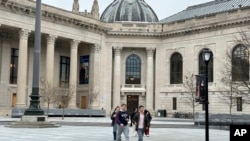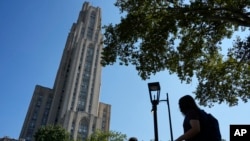Student Union
- By Julie Taboh
Education Expert Lynn Pasquerella Extols Value of Liberal Arts Education
"Liberal education is more critical than ever if we take into account our nation's historic mission of educating for democracy," Lynn Pasquerella, president of the Association of American Colleges and Universities, said.
Those statements come as an increasing number of small, liberal arts colleges in America are closing or being taken over by larger academic institutions... and as the number of international students coming to the U.S. is at an all-time high. (According to a recent report by Open Doors 2019, recently released by the Institute of International Education (IIE) and the U.S. Department of State’s Bureau of Educational and Cultural Affairs).
Pasquerella spoke in detail about this topic, and touched on many other issues in an in-depth interview with VOA earlier this month at the AAC&U offices in Washington.
The following is a transcript of the full interview.
VOA: Thank you for taking the time to sit with me today. First, tell us about your association.
Lynn Pasquerella: The Association of American Colleges and Universities has a mission of advancing the vitality and public standing of liberal education equity and quality as the foundations for excellence in undergraduate education in service to democracy.
VOA: Let's talk about the status of small liberal arts colleges across the US. Where is it right now and what's happening with them?
Pasquerella: There's a prevailing national rhetoric that calls into question the value of higher education in general, and liberal education in particular.
A number of small liberal arts colleges are at risk, in part because of this rhetoric, but also because they have served very distinctive missions. Many small, faith-based institutions in the past, had relied on the clergy, to do administrative work, to teach classes. And as their numbers are dwindling, the colleges are finding that they're having trouble keeping up with the payroll.
But there are many, many liberal arts institutions that are thriving today, and at AAC&U we believe that that mission is more critical than ever.
VOA: Can you give me some examples of colleges that have either closed or been taken over by larger academic institutions, and examples of colleges that are doing okay.
Pasquerella: In the headlines recently there has been attention paid to places like Mount Ida College, looking at a partnership with the University of Massachusetts being absorbed by that. Marlborough College is looking at a perspective absorption by Emerson, that's being contested right now.
At Sweetbriar and Hampshire colleges we’re thinking about ways that they could partner with other institutions -- the Board of Sweetbriar made a decision to close the college, but the alumni got together and revitalized the college and it is continuing to grow and strengthen.
Hampshire College decided a year and a half ago not to admit a first year class, but they have allowed students who had already been admitted to the college to attend if they chose to and are very active in recruiting a new class, and their numbers continue to grow.
So these are colleges that have been at risk, who have looked at innovative ways to take new directions... there's a recent book out by Mary Marcy -- who is the president of Dominican [University] in California -- and her book focuses on the small college imperative and the ways that colleges that are committed to the liberal arts, but are small, can partner with others with business and industry K through 12 to create new pathways for excellence for student success.
And so, colleges like Bates College have new innovative programs that are connecting curriculum to career in ways that will help address some of the concerns of the skeptics around the fact that a liberal education is seen as inconsistent with employability in this world that is STEM-focused.
VOA: What is your assessment of Trinity College? Like many colleges, it's had its set of challenges, but seems to be doing well.
Pasquerella: Trinity College is a very prestigious, liberal arts institution in Connecticut -- was founded in 1823 with a mission to promote the Liberal Arts and Sciences, and since then has retained a reputation for excellence in the Liberal Arts and Sciences.
But they also have established themselves as an anchor institution, and they demonstrate the ways in which their success is inextricably linked to the success of those in the communities that they seek to serve -- and so they do have partnerships with business and industry with K through 12 in the Hartford region. And I think that makes all the difference at a time when we are trying to establish new pipelines for a diverse populations in liberal arts colleges.
VOA: What are some of the reasons colleges are closing, or being taken over by other academic institutions?
Pasquerella: There are a variety of reasons why small liberal arts colleges are closing.
There has been a disinvestment in higher education.
And there's also been this rhetoric that I mentioned where liberal arts colleges are being called into question.
There has been a shift away from the notion of higher education as a public good, to viewing it as a private commodity. So tuition in exchange for jobs, and as tuition-driven institutions have needed to increase their tuition and fees, there's been some skepticism about the value added of that type of education.
And so many students are going to community college, to public institutions, as a way of dealing with the cost.
They may transfer into four-year independent ... colleges but that's had some impact.
And the fact that we have so many options. One of the great strengths of American higher education is the diversity of the types of institutions. We know that you can get an education that is a quality education at a two-year Community College, a four year public research-1 institution, a whole range of institutions, and so these options have created some challenges and risks for small liberal arts colleges.
VOA: Some experts say some of these liberal arts colleges have had financial difficulty and therefore closing because funds are being allocated to nonacademic initiatives like sports, sports facilities, things like that. What is your opinion about that?
Pasquerella: These are issues that we need to address; the issues of cost and allocation of scarce resources. When we're talking about places like Trinity, or other small liberal arts colleges, they are most likely Division-3 schools so they're not spending enormous amount of money on athletics, they don't have athletic scholarships, but they recognize the importance of making sure that students have curricular and co-curricular experiences -- that they are learning, not only in the classroom, but issues of leadership outside of the classroom as well.
VOA: What are some of the ways these problems can be mitigated?
Pasquerella: Leaders of small liberal arts colleges need to tell their story in a more compelling way, not only to those inside of the academy, but to those outside of the academy as well, who may be skeptical about the value of a liberal education at a time when rapidly changing technology means rapid obsolescence.
And in a world that is globally interdependent, the best preparation that we can offer students is one that teaches them to write, speak and think with precision, coherence and clarity, to anticipate and respond to objections, to engage in moral imagination, imagining what it's like to be in the shoes of another different from oneself, and to be adaptable and flexible in the face of that rapid change.
That's exactly what a liberal education does for students. The narrow technical training that has been promoted by many individuals today, places students at risk because once those resources are outsourced or replaced by new technologies, the students lose the capacity to become innovators in their own lives without a liberal arts background.
We don't think at AAC&U that there is an inconsistency between a liberal education and technical or pre-professional education. We think a liberal education can be applied to students at all types of institutions, and that's what we are championing at our organization.
VOA: We have a very vibrant body of international students who come to the U.S. to attend all kinds of colleges. Many -- especially people coming from Asia and the Middle East -- like to attend STEM schools. What do you say about that when it comes to liberal arts colleges?
Pasquerella: Liberal education is a distinctively American tradition, and yet what we're seeing is that institutions in China, in Korea, in the Middle East, are asking for our help in developing a liberal arts curriculum for their students, because they are concerned about the Fourth Industrial Revolution, and the ways that technology will be brought to bear on the lives and livelihood of people there.
I was just serving on a commission for the National Academy of Arts and Sciences looking at the integration of arts and humanities, with science, technology, engineering, math and medicine, and the conclusion of that report is that this integration is more important than ever, as we help students deal with the unscripted challenges of the future, and prepare for jobs that haven't yet been invented.
And so there is a recognition worldwide that this education is critical to the success of our students -- not only upon graduation, but throughout their lives. At a time when life spans are growing, how do we help people engage in lifelong learning, and to live lives that will enable them to flourish fully as human beings, as individuals and in their communities?
VOA: Let's talk a little bit about the state of co-education across college campuses. Trinity College is celebrating 50 years of going co-ed. And you were head of a small liberal arts women's college. So when did co-education really start to pick up steam in this country and what would you say about the impact that has had on higher education?
Pasquerella: Well Mount Holyoke College where I was the president was the first women's college in the country established in 1837. And there was a need because colleges and universities were not by enlarge open to women. And so it was seen as the equivalent to the Ivy League. And opportunities for women and the seven sister institutions that were formed after 1837, focused on equal opportunity to educational access for women.
In the ‘70s, there was a move toward co-education, in part because there was a recognition that women had the right to go to some of the Ivy League schools where they had been denied access, and some of the so-called ‘Little Ivys.’
At that moment in time, places like Vassar College went coed, and there were a number of other women's colleges that made a decision to admit men as women were being admitted to places like Dartmouth and a whole range of other institutions that were being challenged legally and ethically to have a more diverse student population.
VOA: What do you think are the benefits and challenges of schools being coed?
Pasquerella: I certainly think there's value in single sex education. At Mount Holyoke, all of the leadership roles were played by women. And we know in co-educational institutions that women are less likely to play leadership roles, because as some have said -- and there was a study at Princeton that showed this -- they didn't think that it was ‘worth the risk.’
And so when we look at the kinds of risks that have been detailed, they're talking about reputational risks, risks to a sense of wellbeing and purpose that are posed when women take on leadership roles.
And we know that women are judged differently than men in terms of their appearance, the fact that they are judged based on a proven track record, as opposed to potential, whereas men are given leadership positions based on their potential and not necessarily on what they've accomplished already.
And so just the different ways in which society judges men and women, has led, I think, to a recommitment to women's education, recognizing that there are still gender gaps in higher education. 25% of the leaders are women. And that has not changed since 1985.
The numbers have increased slightly to 33%, if we take into account leadership of community colleges, but of course those are the institutions that we devalue in our society.
But if you look at Research-1 institutions, the places that are valued most highly, very few women are leading those institutions, and so we need to look at the barriers to leadership in the academy and how we can address those given that more than 50% of college students are female. What are the persistent barriers, hidden biases that mitigate against women's leadership in the academy?
VOA: Let's talk briefly about members of the LGBT community. Where do they fit into all this and how does that factor into the equation?
Pasquerella: It's a great question. At Mount Holyoke we made a decision under my presidency in 2014 to admit any student who identified as a woman, or who was biologically female at birth.
So this allowed for students -- all students -- to come to Mount Holyoke except those who identified as male. And for many people, this was a concern, others celebrated it and thought that it was about time that we recognized that the category of woman is not static.
And at times of gender fluidity and a recognition that identity is so grounded in cultural norms, we wanted to be as inclusive as possible while recognizing our commitment to being a women's college and to serving women.
VOA: Any last comments about the status of liberal arts colleges and the U.S?
Pasquerella: Liberal education is more critical than ever if we take into account our nation's historic mission of educating for democracy. And at a time when we are existing in what seems to be a post-truth era, when facts are being questioned, when evidence is being challenged, helping students to discern the truth and the power of a liberal education is crucial.
Academic leaders must take up the charge to ensure that all of our citizens have the right to a liberal education.
VOA: Thank you so much for your time.
See all News Updates of the Day
- By VOA News
Competition grows for international students eyeing Yale

It’s tough to gain admission to Yale University, and it’s getting even tougher for international students as standout students from around the world set their sights on Yale.
The Yale Dale News, the campus newspaper, takes a look at the situation here.
- By VOA News
Student from Ethiopia says Whitman College culture made it easy to settle in

Ruth Chane, a computer science major from Ethiopia, writes about her experiences settling into student life at Whitman College in the U.S. state of Washington.
"The community at Whitman College made sure I felt welcomed even before I stepped foot on campus," she says.
- By VOA News
Claremont Colleges student gets a shock when she heads home to Shanghai

In The Student Life, the student newspaper for the Claremont Colleges, a consortium of five liberal art colleges and two graduate schools in Claremont, California, student Rochelle Lu writes about readjusting to her Shanghai home after spending a semester in the United States.
- By VOA News
Cedarville University aims to ease transition for international students

Cedarville University in the U.S. state of Ohio says it’s got more than 140 international students representing 44 countries.
Here, the school interviews Jonathan Sutton, director of international student services. He talks about his job and the opportunities for international students on campus.
- By VOA News
Morehouse College offers prospective students tips on applying and thriving

Morehouse College, a private, historically Black liberal arts college in the U.S. state of Georgia, offers a guide for international students interested in attending the school.
Among the tips to apply and thrive at Morehouse:
- Take advantage of the school’s orientation program
- Turn to the school’s Center for Academic Success for tutoring, support and more
- Immerse yourself in campus life via clubs and societies
- By Reuters
US reviews Columbia University contracts, grants over antisemitism allegations

The administration of President Donald Trump said on Monday it will review Columbia University's federal contracts and grants over allegations of antisemitism, which it says the educational institution has shown inaction in tackling.
Rights advocates note rising antisemitism, Islamophobia and anti-Arab bias since U.S. ally Israel's devastating military assault on Gaza began after Palestinian Hamas militants' deadly October 2023 attack.
The Justice Department said a month ago it formed a task force to fight antisemitism. The U.S. Departments of Health and Education and the General Services Administration jointly made the review announcement on Monday.
"The Federal Government's Task Force to Combat Anti-Semitism is considering Stop Work Orders for $51.4 million in contracts between Columbia University and the Federal Government," the joint statement said.
The agencies said no contracting actions had been taken yet.
"The task force will also conduct a comprehensive review of the more than $5 billion in federal grant commitments to Columbia University."
The agencies did not respond to requests for comment on whether there were similar reviews over allegations of Islamophobia and anti-Arab bias.
Columbia had no immediate comment. It previously said it made efforts to tackle antisemitism.
College protests
Trump has signed an executive order to combat antisemitism and pledged to deport non-citizen college students and others who took part in pro-Palestinian protests.
Columbia was at the center of college protests in which demonstrators demanded an end to U.S. support for Israel due to the humanitarian crisis caused by Israel's assault on Gaza. There were allegations of antisemitism and Islamophobia in protests and counter-protests.
During last summer's demonstrations around the country, classes were canceled, some university administrators resigned and student protesters were suspended and arrested.
While the intensity of protests has decreased in recent months, there were some demonstrations last week in New York after the expulsion of two students at Columbia University-affiliated Barnard College and after New York Governor Kathy Hochul ordered the removal of a Palestinian studies job listing at Hunter College.
A third student at Barnard College has since been expelled, this one related to the occupation of the Hamilton Hall building at Columbia last year.
Canada’s immigration overhaul signals global shift in student migration
From Europe to North America, nations are tightening their immigration policies. Now Canada, long seen as one of the world's most welcoming nations, has introduced sweeping changes affecting international students. The reforms highlight a growing global trend toward more restrictive immigration policies. Arzouma Kompaore reports from Calgary.
Trump administration opens antisemitism inquiries at 5 colleges, including Columbia and Berkeley

The Trump administration is opening new investigations into allegations of antisemitism at five U.S. universities including Columbia and the University of California, Berkeley, the Education Department announced Monday.
It's part of President Donald Trump's promise to take a tougher stance against campus antisemitism and deal out harsher penalties than the Biden administration, which settled a flurry of cases with universities in its final weeks. It comes the same day the Justice Department announced a new task force to root out antisemitism on college campuses.
In an order signed last week, Trump called for aggressive action to fight anti-Jewish bias on campuses, including the deportation of foreign students who have participated in pro-Palestinian protests.
Along with Columbia and Berkeley, the department is now investigating the University of Minnesota, Northwestern University and Portland State University. The cases were opened using the department's power to launch its own civil rights reviews, unlike the majority of investigations, which stem from complaints.
Messages seeking comment were left with all five universities.
A statement from the Education Department criticized colleges for tolerating antisemitism after Hamas' Oct. 7, 2023, attack on Israel and a wave of pro-Palestinian protests that followed. It also criticized the Biden administration for negotiating "toothless" resolutions that failed to hold schools accountable.
"Today, the Department is putting universities, colleges, and K-12 schools on notice: this administration will not tolerate continued institutional indifference to the wellbeing of Jewish students on American campuses," said Craig Trainor, the agency's acting assistant secretary for civil rights.
The department didn't provide details about the inquiries or how it decided which schools are being targeted. Presidents of Columbia and Northwestern were among those called to testify on Capitol Hill last year as Republicans sought accountability for allegations of antisemitism. The hearings contributed to the resignation of multiple university presidents, including Columbia's Minouche Shafik.
An October report from House Republicans accused Columbia of failing to punish pro-Palestinian students who took over a campus building, and it called Northwestern's negotiations with student protesters a "stunning capitulation."
House Republicans applauded the new investigations. Representative Tim Walberg, chair of the Education and Workforce Committee, said he was "glad that we finally have an administration who is taking action to protect Jewish students."
Trump's order also calls for a full review of antisemitism complaints filed with the Education Department since Oct. 7, 2023, including pending and resolved cases from the Biden administration. It encourages the Justice Department to take action to enforce civil rights laws.
Last week's order drew backlash from civil rights groups who said it violated First Amendment rights that protect political speech.
The new task force announced Monday includes the Justice and Education departments along with Health and Human Services.
"The Department takes seriously our responsibility to eradicate this hatred wherever it is found," said Leo Terrell, assistant attorney general for civil rights. "The Task Force to Combat Anti-Semitism is the first step in giving life to President Trump's renewed commitment to ending anti-Semitism in our schools."
- By VOA News
STEM, business top subjects for international students

The Times of India breaks down the most popular subjects for international students to study in the U.S.
STEM and business lead the pack. Read the full story here. (January 2025)
- By VOA News
Safety and visa difficulties among misconceptions about US colleges

U.S. News & World report addresses some of the misconceptions about U.S. colleges and universities, including the difficulty of getting a visa.
Read the full story here. (January 2025)
- By VOA News
Work opportunities help draw international students to US schools

US News & World Report details the three top factors in foreign students' decision to study in the U.S. They include research opportunities and the reputation of U.S. degrees. Read the full story here. (December 2024)
- By VOA News
British student talks about her culture shock in Ohio

A British student who did a year abroad at Bowling Green State University in Ohio talks about adjusting to life in America in a TikTok video, Newsweek magazine reports.
Among the biggest surprises? Portion sizes, jaywalking laws and dorm room beds.
Read the full story here. (December 2024)
- By VOA News
Harvard's Chan School tells international students what to expect

Harvard's T.H. Chan School of Public Health reaches out to international students by detailing the international student experience at the school.
Learn more about housing, life in Boston and more here.
- By Reuters
China unveils plan to build 'strong education nation' by 2035

China issued its first national action plan to build a "strong education nation" by 2035, which it said would help coordinate its education development, improve efficiencies in innovation and build a "strong country."
The plan, issued Sunday by the Communist Party's central committee and the State Council, aims to establish a "high quality education system" with accessibility and quality "among the best in the world."
The announcement was made after data on Friday showed China's population fell for a third consecutive year in 2024, with the number of deaths outpacing a slight increase in births, and experts cautioning that the downturn will worsen in the coming years.
High childcare and education costs have been a key factor for many young Chinese opting out of having children, at a time when many face uncertainty over their job prospects amid sluggish economic growth.
"By 2035, an education power will be built," the official Xinhua news agency said, adding that China would explore gradually expanding the scope of free education, increase "high-quality" undergraduate enrolment, expand postgraduate education, and raise the proportion of doctoral students.
The plan aims to promote "healthy growth and all-round development of students," making sure primary and secondary school students have at least two hours of physical activity daily, to effectively control the myopia, or nearsightedness, and obesity rates.
"Popularizing" mental health education and establishing a national student mental health monitoring and early warning system would also be implemented, it said.
It also aims to narrow the gap between urban and rural areas to improve the operating conditions of small-scale rural schools and improve the care system for children with disabilities and those belonging to agricultural migrant populations.
The plan also aims to steadily increase the supply of kindergarten places and the accessibility of preschool education.
- By VOA News
A look at financial aid options for international graduate students in US

The Open Notebook, a site focusing on educating journalists who cover science, has complied a list of U.S. graduate program financial aid information for international students.









